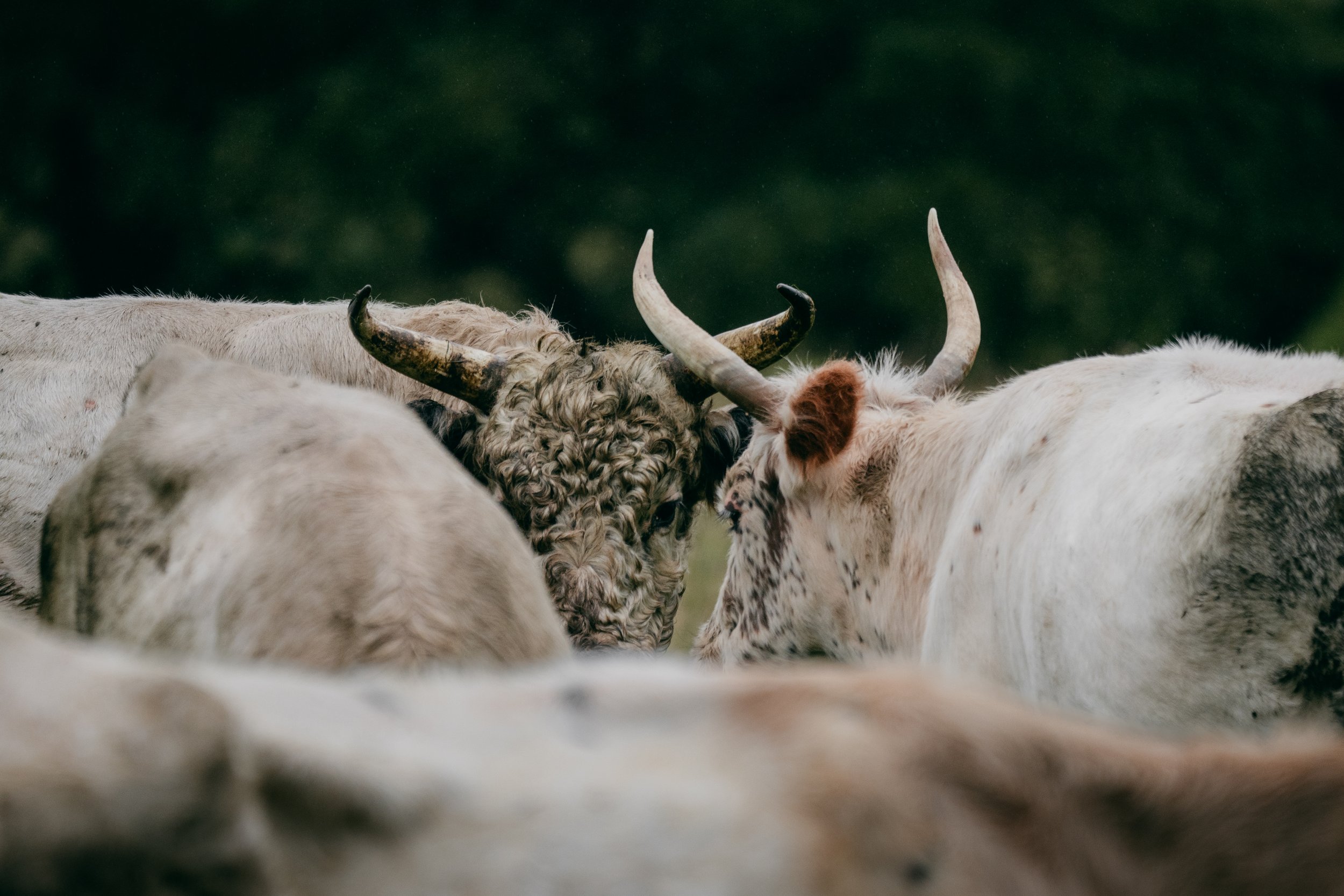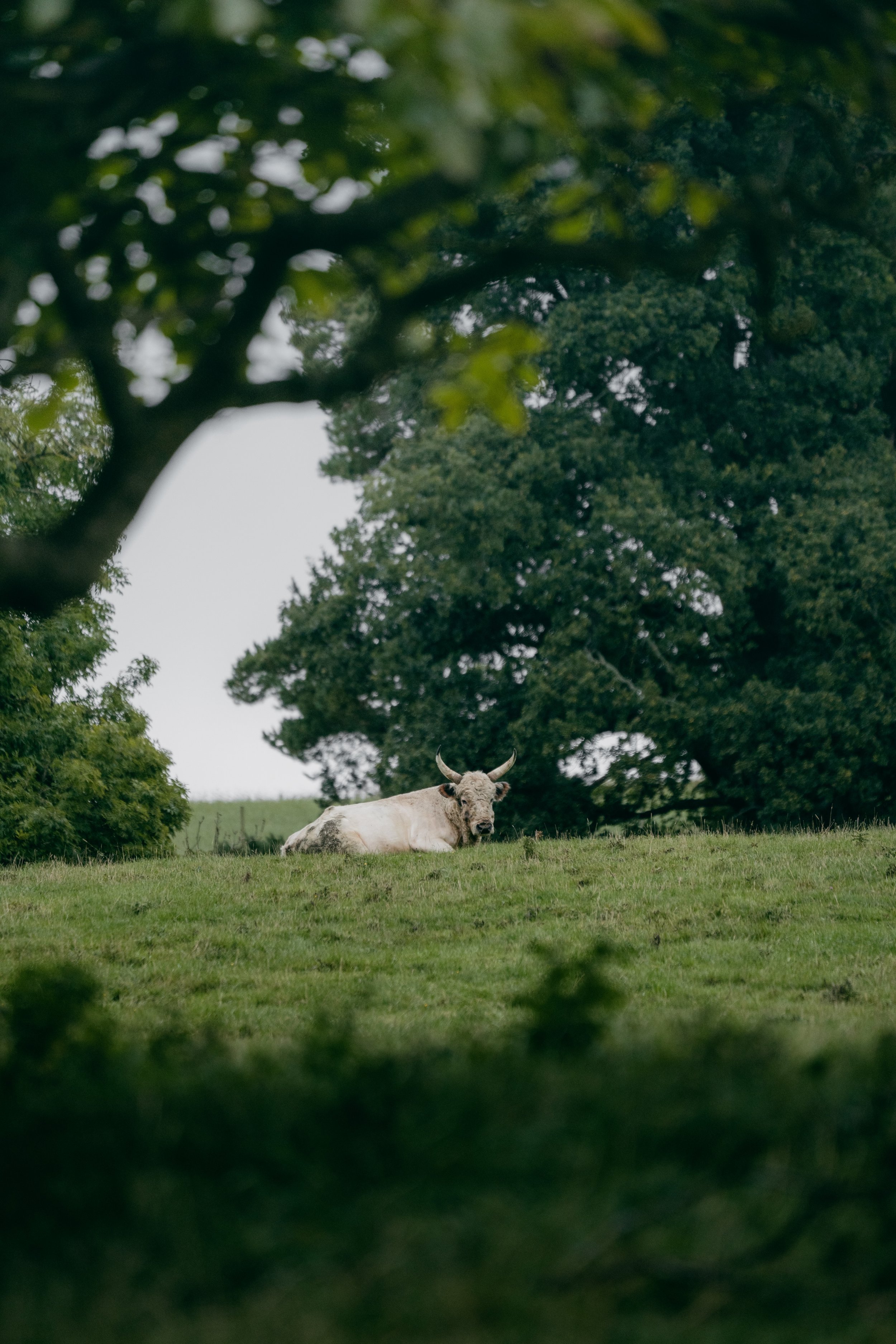The Wild Beasts of Chillingham
In the northernmost reaches of Northumberland, a peculiar, low bellowing noise reverberates around the walls of the medieval Chillingham Castle. This strange sound is emanating from a critically endangered herd of majestic white cattle which has roamed the estate grounds, completely free from human interference, since the 1300s. The wild cattle of Chillingham are totally different to the docile domestic breeds we are familiar with in modern times. Leaner, smaller and with long menacing horns, they offer a window into the distant past, when beasts like these roamed our ancient forests.
Presently numbering around 130, the wild cattle of Chillingham are some of the rarest animals on the planet. Totalling far fewer than the world’s most threatened species such as the Siberian tiger or mountain gorilla, these porcelain white, wiry beasts with elongated heads and unpredictable temperaments are distinguishably different from the domesticated cattle of today. Thought to be among the last remaining wild cattle in the world, they retain a primaeval instinct and untamed character. Remarkably, of the 1.2 billion cattle in the world, only the herd at Chillingham (and a few on oceanic islands) lives completely free from human intervention.
The herd is thought to have been penned into the great park at Chillingham Estate during the 14th century, when medieval blood sports were prevalent. The cattle were treated like large game animals and allowed to live a completely natural existence in order to preserve their fight or flight response. Residents of the nearby castle are likely to have ridden through the park on horseback with hounds and weapons, chasing the herd of beasts in near ‘wild’ hunting pursuits.
In recent times, there has been much debate as to whether the species are descendants of medieval aurochs, the ancestors of today’s domestic cattle. This has been fuelled by discoveries within the castle grounds, including skeletal remains of aurochs, and a 2nd-century terracotta oil lamp complete with bristly fur and classifiable horns – starkly resembling that of a Chillingham cattle head. These findings prompted speculation that the Romans, known for their adoration of white animals, may have been the first to encounter the species. Believing white animals to be pure, they were often sacrificed in Mithraic rituals which were common practice during this period. Although it’s a interesting thought, the Chillingham cattle are not believed to be any more similar to aurochs than other modern breeds are that we see today. Despite it being unlikely that these animals are descendants of the medieval species, the cattle still offer a remarkable insight into how the aurochs may have behaved in a truly natural herd structure.
Unusual in the domesticated bovine world, Chillingham cattle breed all year round and competition among the males is fierce, bloody and sometimes fatal. Many of the bulls roaming these grounds bear grizzly scars of battles gone by, and with no veterinary intervention, some seem lucky to be alive. Eye injuries, puncture wounds and broken bones are all common occurrences, but must heal of their own accord. These are wild animals, and the wardens are obliged to let nature runs its course. In the past, when numbers were lower, the herd recognised a ‘king bull’ who would hold the right to mate with all the females within the group. However, over recent decades, as numbers have increased, there have been notable changes in this expected behaviour. Today, smaller groups of reproductive cattle hold territory in different areas of the park, and within each of those groups there is a known dominant bull. The reproductive males within each faction spend a great deal of time working out who is in charge. They regularly challenge each other by bellowing, pawing the ground and exhibiting their enormous size and strength. Fighting is frequent, ferocious and occasionally deadly. Whilst it is quite unusual for a bull to live longer than 12 years, rather pleasantly, a collection of aging bulls has recently sought the company of one another. Forming a team, the old males have retired themselves to the highest elevations of the park and now live a more peaceful existence away from the boisterous teenage bulls vying for dominance below.
The very survival of the herd is regarded as somewhat of a scientific marvel, as throughout history inbreeding is well documented to cause populations to die out. Many studies indicate that restricted gene pools often make animal populations increasingly vulnerable to birth defects and infectious diseases. For the best part of 1,000 years, inbreeding has resulted in extraordinarily high levels of genetic uniformity, reaching a point where the animals are effectively genetic clones of one another. Simply put, not enough genetic diversity now exists between the cattle for harmful mutations to occur. The last recorded mutation was over 20 years ago, but still serves as an important example of how the herd maintains this fragile equilibrium. In this particular case, a calf born without a tail was hastily abandoned by its mother and cast aside by the herd, the new-born dying shortly after desertion. It may seem a merciless trait, but whatever caused this defect was ultimately denied the chance to be passed on.
Survival has been a long and arduous lesson for the herd of Chillingham cattle, which has been perilously close to extinction on numerous occasions. This was most notably the case in 1947, when one of the harshest winters ever recorded saw the total population drop to as low as 13. Prior to the fierce blizzards, 40-feet snow drifts and sub-zero temperatures, numbers were already dwindling. The ensuing inhospitable conditions claimed the lives of over 20 cattle. Only five bulls and eight cows remained. Thankfully, subsequent years proved more favourable, and numbers began to recover once again. Aside from adverse weather, the most significant threat to the survival of the species is disease. Again, the cattle possess their own instinctive measures to protect their existence. Typically, those within the herd who become ill will voluntarily remove themselves from the group and pass away in isolation. If the infected beast fails to abscond, for the good of the herd, it will be forced out, or gruesomely gored to death. 20 years after the frightful winter storms, the species was on the brink of extinction once again. In 1967, foot and mouth disease was rampant in the United Kingdom and came within two miles of the park. Any closer, and the cattle would have been culled. This scare prompted innovative measures to help safeguard the future survival of the species. Frozen embryos now reside in secret laboratories and a backup herd, numbering approximately 30 cattle, now roams an undisclosed location in south-east Scotland.
For now, though, the herd is thriving, and the population is the highest it has been since record-keeping began. Much of the recent success of the species can be attributed to the careful stewardship which aims to look after the cattle’s interests, whilst keeping the animals entirely wild. As such, human involvement is limited to leaving out hay in the harsh winter months and putting an animal out of its misery if it is sick or injured beyond recovery.
Left to run wild, Chillingham cattle have remained untamed and untouched for centuries. The cattle’s behaviour is entirely natural and a result of an 800-year isolated battle for survival. Today, visitors are confronted with a sight unchanged since the medieval era. A herd of rare genetic phenomena, living in a completely natural state. Captivatingly, this is the total world population, and can only be seen at Chillingham.
As featured in This Is Northumberland 2022








